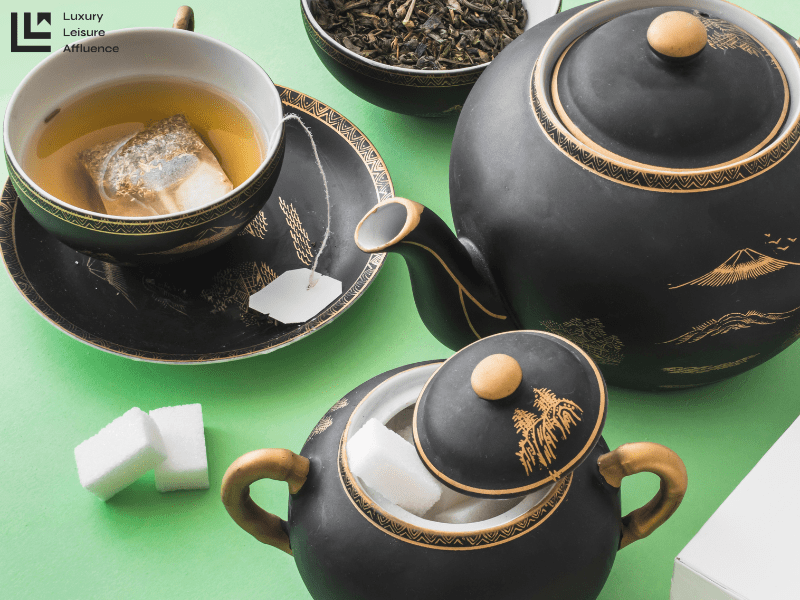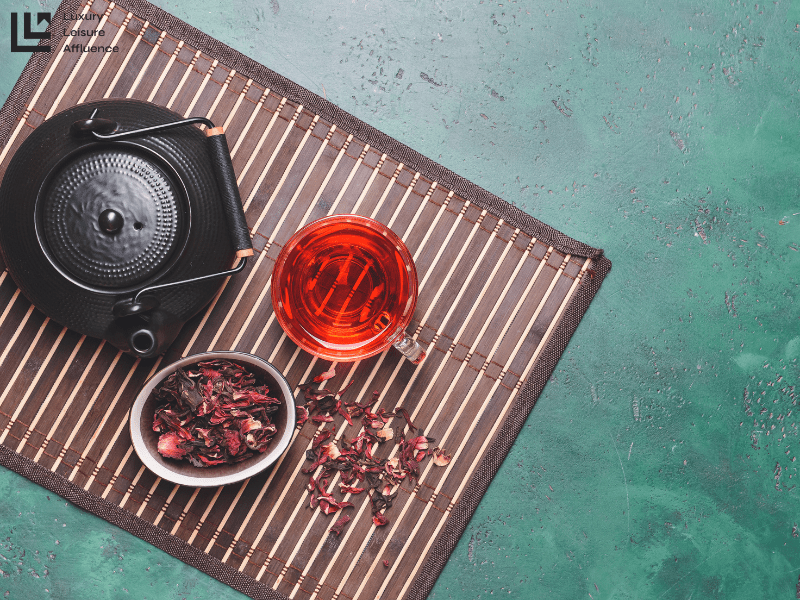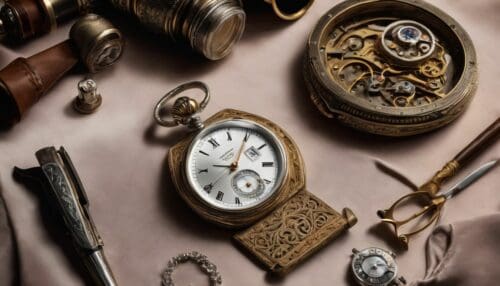Updated On: February 18, 2024 by Raghda Elsabbagh
If there’s anything the British are known for, it’s their ‘sacred’ afternoon teatime. It’s unsurprising, then, to discover that some of the world’s most exquisite and expensive teas are available in the UK. But how much are you willing to pay for the perfect cuppa? If you’re a tea connoisseur who would appreciate a good cup of rare and exquisite tea and willing to spend a fortune on one, this article is for you.
Join us as we define the most opulent tea experiences in the UK and unravel the story behind teas that found their place among the crème de la crème of teas, earning their stripes as the most expensive teas in the UK.

Da Hong Pao: The World’s Most Expensive Tea
Da Hong Pao is one of the world’s most famous and expensive teas, with some varieties selling for 1.2 million dollars per kilogram—which come from the ‘mother tree’ of which there are 6 remaining in the world. Also known as Big Red Robe, Da Hong Pao is a highly prized and rare oolong tea from a small area of the Wuyi Mountains in the Fujian province of China. The tea is made from the leaves of old-growth tea bushes that are said to be over 300 years old. It is renowned for its rich history, unique flavour profile, and limited availability, making it one of the most sought-after teas in the world.
History and Legend
The legend of Da Hong Pao dates back to the Ming Dynasty, where it is said that the mother of An emperor fell ill, and a monk presented her with a tea that miraculously cured her. In gratitude, the emperor sent red robes to clothe the tea bushes, hence the name “Big Red Robe.” Over the centuries, this tea has been passed down from generation to generation, with cuttings from the original mother bushes carefully cultivated.
Terroir and Growing Conditions
Da Hong Pao is grown in the Wuyi Mountains, a UNESCO World Heritage site known for its unique rocky terrain, mineral-rich soil, and ideal climate for growing tea. The specific terroir of the region contributes significantly to the tea’s distinctive flavour. The bushes are grown on cliffs, which receive misty and humid conditions, providing an environment that encourages the development of unique and complex flavours.
Processing
Da Hong Pao is an oolong tea, a category that falls between green and black tea in terms of oxidation. This tea is crafted using rare tea leaves harvested only from legendary bushes with healing legends on specific days each year. The leaves undergo meticulous and labour-intensive processing. They are wiped with goat’s milk for shine, matured, and then aged for up to 80 years before being utilised to create a delightful infusion. They are processed using traditional methods, involving withering, rolling, oxidation, and roasting the leaves over charcoal fires. The oxidation level can vary, resulting in a spectrum of flavours boasting notes of dark cocoa and a profound fruity aroma.
Flavour Profile
The flavour profile of Da Hong Pao is often described as complex and evolving. The tea requires precise serving at 95°C (203 degrees F). It can exhibit notes of orchid, honey, and a subtle roasted character. The tea is also highly aromatic, with a fragrance that is said to linger in the mouth long after the tea has been consumed. Its flavour is reminiscent of Japanese brown rice tea, with woody and umami undertones and peachy notes.
The aftertaste, known as “yan yun” or rock rhyme, is a lingering sweetness that adds to the tea’s allure. The balance between these elements makes Da Hong Pao highly esteemed among tea connoisseurs.
Limited Availability and Rarity
True Da Hong Pao is exceptionally rare, often produced in small quantities from the original tea bushes that have been carefully preserved for centuries. Authentic Da Hong Pao is considered a luxury tea sold at a premium price of $295 per cup due to its scarcity and high demand.
Cultural Significance
Da Hong Pao holds cultural significance in China and is often regarded as a prestige and good fortune symbol. It has become a popular gift for special occasions and to important people such as kings, presidents, celebrities, and dignitaries and is frequently enjoyed during traditional Chinese tea ceremonies.
Where Can You Enjoy Da Hong Pao Tea?
The Royal China Club offers the UK’s most expensive tea experience in London’s Baker Street. The Royal China Club simmers the leaves for eight hours, selling a pot of this exquisite tea for £388 or nearly $600.
Ceylon Golden Tips: The UK’s Most Expensive Tea
Ceylon Golden Tips is another rare and distinguished blend that has captured the attention of connoisseurs, earning its place among the most expensive teas in the UK.
Origins and Rarity
Ceylon Golden Tips Tea traces its roots to the emerald landscapes of the Sri Lankan highlands, where the climate and elevation create the perfect conditions for cultivating exceptional quality tea.
Ceylon Golden Tips is a rare gem. Why? Because of its exclusivity, with only a limited quantity available in select regions of Sri Lanka due to the meticulous handpicking process involved in harvesting the tiny, succulent shoots of a special tea plant at sunrise. The rarity of Ceylon Golden Tips contributes significantly to its elevated status in the world of fine teas.
Historical Origins
Delving into the historical archives, we discover that Ceylon Golden Tips has a legacy of exclusivity and high prices in London that extends back to the 19th century. In 1891, a pound of Golden Tips caused a stir in the tea market, selling for a jaw-dropping £1,260 in London. The tea has gained a reputation for being one of the world’s finest and most exclusive teas, which has led to its high price tag. Fast forward to today, this handpicked blend is reintroduced back to the city, reviving a tea with a rich and fascinating history.
The Craftsmanship
Crafting Ceylon Golden Tips Tea is an art form in itself. The production process is very time-consuming and requires a great deal of manual labour, which adds to the cost of production. Expert tea pluckers delicately and skilfully handpick the tea plant’s tips, and then the chosen buds bask in the sunlight on a velvet cloth, transforming from silver to gold. It’s a work of art, carrying the essence of tradition and craftsmanship in every sip.
Tasting the Elegance
Now, let’s talk about taste. Ceylon Golden Tips Tea is the epitome of refined taste and elegance. This tea promises a sensory journey characterised by a smooth, light, and mellow texture coupled with delicate fruity notes. The best part? You can infuse those golden leaves up to three times, unlocking new layers of flavour each time.
Where Can You Enjoy Ceylon Golden Tips Tea?
Hold onto your teacups because Golden Tips at The Rubens at the Palace in London is nothing short of regal! Priced at £500 for a pot serving three cups, the afternoon tea team at The Rubens handles the golden leaves with gold tweezers, infusing them using still-natural mineral water and pouring the tea from a special silver tea set. This meticulous attention to detail transforms the entire tea-drinking experience, ensuring that patrons not only taste but also appreciate the true essence of this luxurious tea.
Darjeeling Tea: Another Expensive Tea in the UK
Darjeeling tea is considered one of the most expensive teas in the UK, and for good reason. Nestled in the West Bengal region of India, in the heart of the Himalayas, Darjeeling tea stands as a testament to the artistry of tea cultivation. Renowned as the “Champagne of teas” for its unique characteristics and exquisite flavour profile, Darjeeling tea has earned its place among the most sought-after and revered teas globally.
Historical Roots of Darjeeling Tea
The story of Darjeeling tea begins in 1839 when Dr. Campbell, often referred to as the founding father, planted the first Camellia Sinensis seeds, marking the inception of Darjeeling tea’s historical journey. By 1841, the government recognised the potential of this exceptional tea, granting the establishment of the first tea nurseries. In the nineteenth century, England witnessed the firm establishment of Darjeeling tea as a ‘fancy tea,’ rapidly gaining popularity. The British presence in Darjeeling since 1820 ultimately led to the transfer of tea gardens to Indian entrepreneurs in 1947.
Growing Conditions and Unique Characteristics
Darjeeling, perched in the mountainous terrain west of the Assam region, experiences a climate characterised by prolonged cold winters, cool summers, and late monsoon rains. This unique geography and climate contribute to a well-balanced set of growing conditions for high-quality tea. The region comprises 87 tea gardens spread over seven valleys at elevations between 800 to 2200 meters above sea level.
The higher elevations and cool, thin air result in smaller tea leaves, intensifying the flavour and imparting a well-defined taste profile. Though smaller and yielding smaller annual harvests, gardens at higher altitudes produce delicate, aromatic teas that are consequently more expensive. This elevation-driven refinement underscores Darjeeling tea’s reputation as a luxurious indulgence.
The Production Process of Darjeeling Tea
Darjeeling tea undergoes a meticulous production process, starting with hand-plucking tea leaves. The 5-step process includes withering, rolling, fermentation, drying, sorting, and packing. The timing of harvesting plays a crucial role, with Darjeeling producing three annual crops: First Flush teas (March-May), renowned for their flowery, fragrant, and delicate taste; Second Flush teas (June-July), deeply aromatic, full-bodied, and intense in flavour; and autumnal Darjeeling teas (October-November), characterised by subtlety.
Example of Darjeeling Tea
A shining example of the luxury of Darjeeling tea is the Silver Tips Imperial Tea from the Makaibari estate. This oolong tea is meticulously plucked by experts on clear, full-moon nights, aligning with optimal harvest conditions. With limited quantities available, this tea presents notes of mango and frangipani, embodying the complexity and subtlety associated with Darjeeling teas, and is sold at $1850/kg. In 2005, a luxury tea firm packed Darjeeling tea in a diamond-encrusted bag, costing $15000/bag, to celebrate its 75th anniversary. While this is an extreme example of the luxuriousness of Darjeeling tea, it is a testament to the high value placed on this exquisite tea.
Renowned for its distinctive taste and unique qualities, Darjeeling tea has earned a prestigious place among the most sought-after and expensive teas in the UK. Its reputation as the “Champagne of teas” is well-deserved, and its popularity shows no signs of waning. Whether enjoyed in a diamond-encrusted tea bag or a simple cup, Darjeeling tea is a true luxury worth the price.

Would You Try the Most Expensive Teas in the UK?
If you are willing to splurge on a truly exquisite tea experience, those 3 teas are definitely worth it! They stand as a testament to the enduring allure of the most expensive teas in the UK. With their rare origins, historical significance, and meticulous craftsmanship, they invite tea enthusiasts on a journey of indulgence and sophistication. Cheers to the fanciest teas in town!











